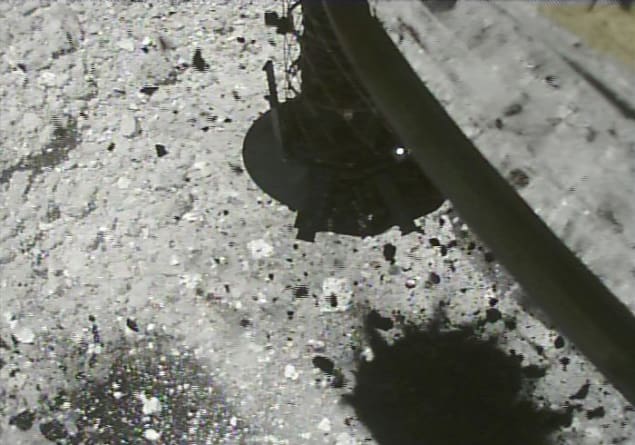Asteroid sample offers clues to the origins of our solar system
13 Jul 2022

The chemical composition of samples collected from the asteroid 162173 Ryugu are strikingly similar to that of the Sun, say members of a team tasked with analysing samples of Ryugu collected by the Hayabusa2 mission. The result suggests that previously observed discrepancies between Ryugu’s composition and that of meteorites known as CI chondrites may be due to the different conditions that they experienced after their formation, rather than a different origin.
Ryugu was first detected by the Lincoln Near-Earth Asteroid Research (LINEAR) project in 1999. It is diamond-shaped, rotates every 7.6 hours, and orbits the Sun between the Earth and Mars. In 2014 the Japanese Aerospace Exploration Agency (JAXA) launched the Hayabusa2 mission with the aim of collecting samples from above and below the asteroid’s surface and returning them to Earth. In 2019 Hayabusa2 accomplished the first part of its mission by shooting a 5-gram tantalum projectile at the asteroid, collecting the ejected pebbles and sand and sealing them inside a capsule. On 6 December 2020, this sealed capsule returned to Earth, enabling scientists to analyse the uncontaminated material.
Puzzling differences
In the latest study, a team led by Kazuhide Nagashima of the University of Hawai‘i at Mānoa, US, Tetsuya Yokoyama of the Tokyo Institute of Technology, Japan, and Hishayoshi Yurimoto of Hokkaido University, Japan, used electron microscopy, radioisotope dating and other techniques to study a 95 mg sample of Ryugu, aiming to determine the conditions it may have experienced during its lifetime. These tests were motivated by earlier observations revealing that while both Ryugu and CI chondrites have similar chemistry to the Sun, they also differ in major ways: Ryugu is darker than all other meteorites, for example, and is more porous than CI chondrites. These differences are puzzling because both are believed to have parent asteroids that originated in the cloud of dust and gas which, due to gravity, eventually collapsed to become our Sun and the surrounding disc.
A key aspect of the team’s analysis focused on Ryugu’s relative lack of water. Even though the asteroid gets its name from an underwater “dragon palace” in Japanese folklore, aqueous liquid is not currently stable there. Radioisotope dating on the Ryugu samples suggests that energy from radioactive decay could have caused the water to melt and eventually escape into space, leading to the relatively dry mudball we observe today. Other hypotheses for Ryugu’s missing water include a concoction of impact heating, solar heating, space weathering, and exposure to the extremely high space vacuum. “Ryugu experienced severe aqueous alteration in the very early stage of its evolution,” says Shogo Tachibana, a professor of space and planetary science at the University of Tokyo and a member of the sample analysis team.
Pristine samples
An alternative hypothesis for the observed elemental differences between Ryugu and CI chondrites is that the latter may have experienced terrestrial contamination during decades spent on Earth, meaning that their chemistries no longer reflect those of their space-based parent bodies. The paper’s scientists note that Hayabusa2’s Ryugu samples are chemically pristine in comparison with others, with Tachibana calling them the “freshest CI chondrite having the elemental composition closest to the Sun among all the meteorites”.READ MORE

Although samples collected from space and returned to Earth are currently rare, this could change over the coming years. JAXA has plans for future missions that would include the collection of samples from Mars’ moon Phobos, while Russia’s Roscosmos and the China National Space Administration plan to gather samples from the Moon. In the meantime, part of the sample from Ryugu is currently touring Japan, whilst a further fraction will remain stored in a chamber filled with nitrogen gas, limiting its exposure to contamination and offering further chances to characterize the formation and evolution of the solar system.
Chaneil James is a freelance science communicator.
FROM PHYSICSWORLD.COM 24/7/2022
Δεν υπάρχουν σχόλια:
Δημοσίευση σχολίου